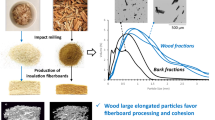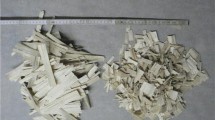Abstract
This study evaluated physical, mechanical and fire properties of oriented strand boards (OSB) covered with fire retardant treated veneers. The beech (Fagus orientalis Lipsky) veneers were treated with either monoammonium phosphate, diammonium phosphate, lime water or a borax/boric acid (1:1 by weight) mixture. Physical and mechanical properties of the specimens were performed according to EN and DIN standards. A cone calorimeter was used to determine their combustion characteristics. The physical and mechanical properties of the specimens were adversely affected by the treatments. The specimens treated with lime water had the best physical performance while the specimens treated with borax/boric acid had the highest mechanical properties. The fire retardant treatments of the face veneers were effective in reducing the initial contribution of heat release to potential fire growth. In particular, the lime water treatment was an effective fire retardant treatment in that it reduced both the effective heat of combustion and the mass loss rate. It also delayed the times for sustained ignition.
Zusammenfassung
In dieser Studie wurden die physikalischen und mechanischen sowie die Brandeigenschaften von OSB mit Feuerschutzmittel imprägnierten Deckfurnieren untersucht. Die Buchenfurniere (Fagus orientalis Lipsky) wurden entweder mit Monoammoniumphosphat, Diammoniumphosphat, Kalkwasser oder einer Borax/Borsäure-Mischung (im Gewichtsverhältnis 1:1) imprägniert. Physikalische und mechanische Eigenschaften der Proben wurden nach EN- und DIN-Normen untersucht. Das Brandverhalten wurde mittels einer Cone-Calorimeter-Prüfung bestimmt. Die Imprägnierung wirkte sich auf die physikalischen und mechanischen Eigenschaften der Proben nachteilig aus. Die mit Kalkwasser imprägnierten Proben wiesen die besten physikalischen Eigenschaften auf, wohingegen die mit Borax/Borsäure imprägnierten Proben die besten mechanischen Eigenschaften hatten. Durch die Feuer hemmende Behandlung der Deckfurniere wurde die Wärmefreisetzung verzögert. Dabei erwies sich die Imprägnierung mit Kalkwasser als besonders wirksam, da sie sowohl die Gesamtwärmefreisetzung als auch die Masseverlustrate reduzierte. Daneben verzögerte sie auch den Entzündungszeitpunkt.
Similar content being viewed by others
References
Akbulut T, Goker Y, Ayrilmis N (2002) Using OSB panels instead of plywood. Review of the Faculty of Forestry, Istanbul University, Series A 52(1):65–79
ASTM International (2004) Standard test method for heat and visible smoke release rates for materials and products using an oxygen consumption calorimeter. ASTM E 1354-04a. ASTM International, West Conshohocken, PA
ASTM International (2004a) Standard test method for measurement of mass loss and Ignitability for screening purposes using a conical radiant heater. ASTM E 2102-04a. ASTM International, West Conshohocken, PA
ASTM International (2004b) Standard test method for surface burning characteristics of building materials. ASTM E 84-04. ASTM International, West Conshohocken, PA
Ayrilmis N (2007) Effect of fire retardants on internal bond strength and bond durability of structural fiberboard. Build Environ 42(3):1200–1206
Ayrilmis N, Kartal SN, Laufenberg T, Winandy JE, White RH (2005) Physical and mechanical properties and fire, decay, and termite resistance of treated oriented strandboard. For Prod J 55(5):74–81
Berkel A (1970) Wood Technology. Forestry Faculty, Istanbul University publication no:1448, Istanbul
Bozkurt Y, Goker Y, Erdin N (1993) Technique of impregnation. Forestry Faculty, Istanbul University, Istanbul University, publication no:3779, Istanbul
Deutsches Institut für Normung (1987) DIN 68765 B1: Spanplatten; Kunststoffbeschichtete dekorative Flachpreßplatten; Begriff; Anforderungen, Germany
Dietenberger MA, White RH (2001) Reaction-to-fire testing and modeling for wood products. In: Proceedings, 12th Annual BCC conference on flame retardancy, 21–23 May 2001, Stamford, CT, pp 54–69
European Committee for Standardization (1993) Wood-based panels. EN 310: Determination of bending strength and modulus of elasticity
EN 323: Determination of density
EN 325: Determination of dimensions of test pieces
EN 326-1: Sampling, cutting, and inspection. Part 1
EN 320: Fiberboards; determination of resistance to axial withdrawal of screws
EN 317: Particleboards and fiberboards – Determination of swelling in thickness after immersion in water
EN 300 (1997) Oriented strand boards (OSB)-Definitions, classification specifications
EN 636 (1996) Plywood-specifications-Part 1: Requirements for plywood for use in dry conditions, Belgium
Goker Y (1978) An investigation on technological properties of Turkish made plywoods, blockboards, particle boards, and development possibilities of these industries in Turkey. Istanbul University publication no. 2489, Forestry Faculty publication no. 267, Istanbul, Turkey
International Organization for Standardization (1993) Fire tests – Reaction to fire – Part 1: Rate of heat release from building products (Cone calorimeter method), ISO 5660-1. ISO, Geneva
Kartal SN, Ayrilmis N (2005) Blockboard with boron-treated veneers: laboratory decay and termite resistance tests. Int Biodeter Biodegr 55(2):93–98
Laufenberg T, Ayrilmis N, White R (2006) Fire and bending properties of blockboard with fire retardant treated veneers. Holz Roh- Werkst 64(2):137–143
Middleton JC, Dragoner SM, Winters FT (1965) An evaluation of borates and other inorganic salts as fire retardants for wood products. For Prod J 15(12):463–467
Myers GC, Holmes CA (1975) Fire retardant treatments for dry-formed hardboard. For Prod J 25(1):23–28
SBA (2006) About OSB: History of oriented strand board. Structural Board Association Ontario, Canada, 1 p, www.osbquide.com/osbhistory.html
Schaeffer RE, Gillespie RH, Blomquist RF (1966) Amonium salt fire retardants and resorsinol resin adhesives. For Prod J 16(5):23–30
Tran HC, LeVan SL (1990) The role of boron in flame-retardant treatments. In: Hamel M (ed) Proceedings, 1st International conference on wood protection with diffusible preservatives, no. 47355, Nashville, TN, 28–30 November 1990, pp 39–41
White R, Dietenberger MA (2004) Cone calorimeter evaluation of wood products. In: Proceedings, 15th Annual BCC conference on flame retardancy, 7–9 June 2004, Stamford, CT, pp 331–342
Author information
Authors and Affiliations
Corresponding author
Rights and permissions
About this article
Cite this article
Ayrilmis, N., Candan, Z. & White, R. Physical, mechanical, and fire properties of oriented strandboard with fire retardant treated veneers . Holz Roh Werkst 65, 449–458 (2007). https://doi.org/10.1007/s00107-007-0195-3
Published:
Issue Date:
DOI: https://doi.org/10.1007/s00107-007-0195-3




